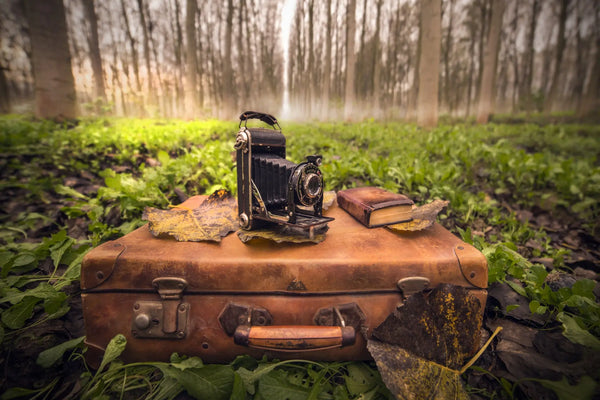
Evolution of camera bags

I had a chat the other day about camera bags. I'm preparing to move house and my friend criticised how many camera bags I have. He commented that in the old days one bag was enough, and they all do the same job.
It got me thinking about camera bags over time, so I did a little bit of digging.
When photographers used folding or box cameras in the 19th or early 20th century, the manufacturer would usually provide a leather case or pouch designed for that camera. They were most often made of hard leather, looking like small suitcases, with just enough space to fit the specific camera, with another case for the glass plates and other paraphernalia as needed.

This was perfectly practical and useful protection for early photographers' gear, travelling long distances on train, ships, and stage-coaches with these bulky systems as part of their general luggage, and where time setting up the camera was needed and thus speed not an issue.
Nothing changed much as cameras developed, as hard cases were the default even up to the invention of SLR and rangefinder cameras, although the "ever ready" shell-like case that could be flipped off for quick access became very popular with photographers who wanted faster access to their camera, or simply the lightest protective case.

It was the interchangeable lens systems, such as pioneered by Leica, that made the close-fit camera bag less attractive, and camera bags became larger with more space for lenses and accessories. They were still, however, hard leather "cases" with little padding or protection, and often either simple empty spaces inside, or leather pockets/clips for film rolls, flash bulbs, lenses and such specific to a system and not very adaptable, and very heavy.

Many used existing satchel/shoulder satchel bags, also heavy, but softer and more flexible.

War/documentary photographers, and journalists, looked to lighter and more flexible alternatives, and fishing bags became a popular choice; Brady fishing bags and/or Barbour jackets in London, amongst other luxury brands, became popular amongst successful photographers: the bags were comfortable, soft, with waterproof waxed canvas, quality bridle leather, they were practical and, importantly for men in those times, masculine in appearance. They were not, however, designed for cameras.

So how did we get to the more recognisable camera bags we see today?
Billingham is major brand in the industry. Mr. Billingham worked as a cutter for Brady, a famous bag maker from Birmingham, UK, and started his own fishing bag company in the early seventies. He noticed established photographers buying fishing bags, with many foreign photographers coming to London to buy the traditional quality brands when on assignment. He saw a market opportunity to offer more photography focused bags, and the Billingham camera bag brand we know today was born.

As a side note, the camera jacket also owes a debt to the sport of fishing, adapted as it is from fishing jackets.

Another significant change came from a journalist who also found the popular fishing bags inadequate for his needs.
Journalists for the Philadelphia Inquirer used to have a car provided, and they kept their camera gear in the trunk in traditional hard cases. The paper changed to a car pool system, meaning the photographers had to carry what they wanted with them, and would't know in advance of an assignment. Jim Domke was one of the journalists and he simply couldn't find a practical and comfortable bag, unhappy as he was with the fishing bags that were popular with many colleagues at the time. He decided to design his own, with soft padded sides and interchangeable inserts, and the rest is history.

Image from J. G. Domke's website.
Here's a video of Jim Domke talking about the history of his camera bags.
These two people pioneered the modern camera bag as we know it. The amateur photography boom from the mid 70's onwards spawned many more iterations and variations of camera bags to the thousands of designs and styles we see today, from single-camera bags, shoulder/messenger bags, to full-sized backpacks, they all owe, IMHO, their origins to these two names.
Practicality has driven the camera bag evolution, in that these changes reflected a real need. For a camera bag to succeed, styling is probably the last consideration after deciding what type of customer might buy it; purpose; capacity/external fixings; size; back/shoulder support; protection (material:weatherproofing/padding/durability etc.); access to gear, and more. Once all of this is agreed, colour and trim follow.
Today we are spoilt for choice. The development of new materials, new markets, manufacturing processes, and global communication and supply chains, has resulted in a choice of camera bag designs and costs that suit practically every budget and need, giving us the opportunity to have a bag for different occasions.

This is why I, and many photographers, have more than one bag. After decluttering (My friend was right about me having too many.) here's my list of bags I use often enough:
How many bags do you have, and what type? We'd love to read your comments.
